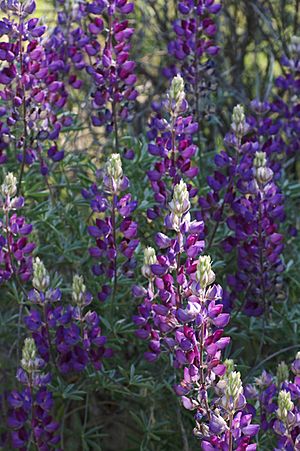Lupinus albifrons facts for kids
Quick facts for kids Lupinus albifrons |
|
|---|---|
 |
|
| Scientific classification | |
| Genus: |
Lupinus
|
| Species: |
albifrons
|
Lupinus albifrons, also called silver lupine, white-leaf bush lupine, or evergreen lupine, is a type of lupine plant. It grows naturally in California and Oregon. You can find it along the coast and in sunny, dry areas like meadows, prairies, and forest clearings. This plant is part of many different plant groups, including coastal sage scrub and chaparral.
Contents
What it Looks Like
The silver lupine is a perennial shrub. This means it lives for more than two years. It can grow up to 5 ft (1.5 m) tall and about 2 ft (0.61 m) wide. Its flowers are light blue to violet. They grow on stalks that are 3–12 inches (7.6–30.5 cm) long. The leaves are special because they look silver. They also have a soft, feathery feel.
Where it Grows Best
This plant grows wild in the hills and valleys of California. It needs soil that drains water well. Once its roots are strong, it does not need much water. This makes it a tough plant.
Why Animals Avoid It
The silver lupine has a bitter taste. This is because it contains natural chemicals called alkaloid toxins. These toxins include anagyrine and lupinine. Because of these chemicals, deer usually do not eat this plant.
These toxins can also make farm animals sick. Young cows might not gain weight as well. If cows are stressed or do not have enough other food, they might eat more lupine. This can cause them to feel unwell.
Helping the Mission Blue Butterfly
The mission blue butterfly is an endangered species. This means it is at risk of disappearing forever. Its caterpillars need certain lupine plants to eat. These include Lupinus albifrons, Lupinus formosus, and Lupinus variicolor.
When the butterfly caterpillars eat the lupine, they also become toxic. This makes them taste bitter to predators. This helps protect the butterflies from being eaten.
Sometimes, silver lupine is removed from areas where farm animals graze. This is done to protect the livestock. However, removing the lupine also takes away a key food source for the mission blue butterfly. This makes it harder for the butterfly to survive.
Different Types of Silver Lupine
Lupinus albifrons has several different types, called varieties. Some of these varieties grow only in California. Others can be found in both California and Oregon.
- Lupinus albifrons var. albifrons
- Lupinus albifrons var. collinus
- Lupinus albifrons var. douglasii
- Lupinus albifrons var. eminens
- Lupinus albifrons var. flumineus


